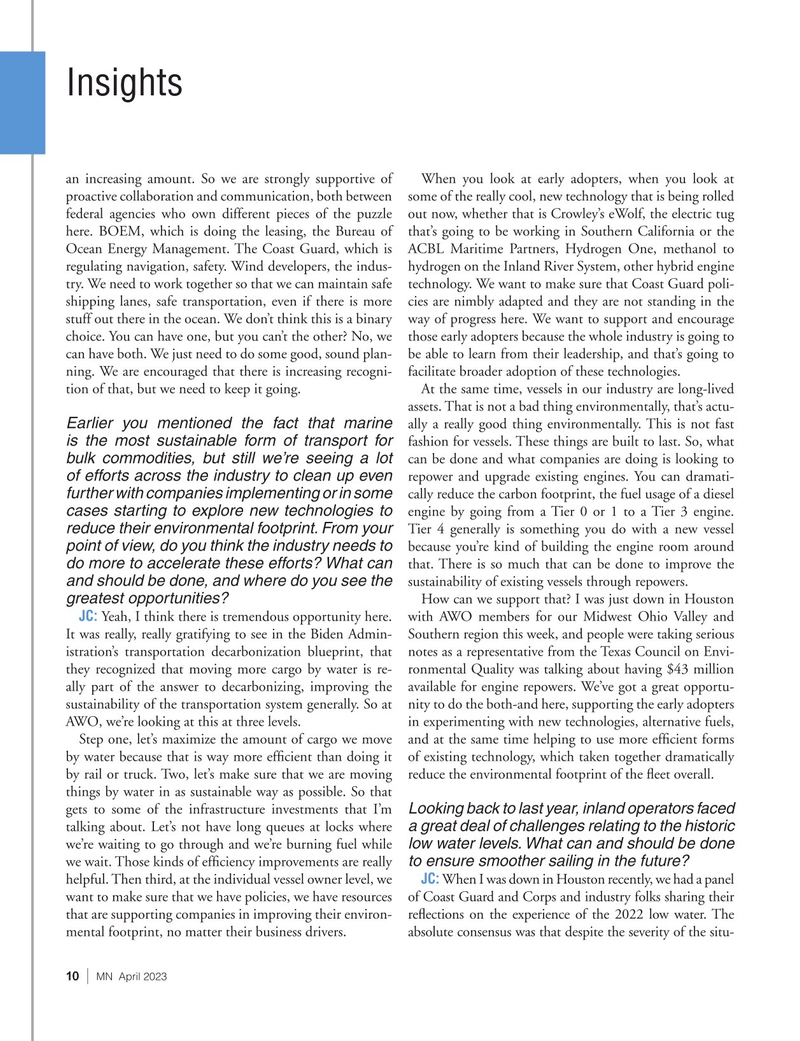
Page 10: of Marine News Magazine (April 2023)
Towboats, Tugs & Barges
Read this page in Pdf, Flash or Html5 edition of April 2023 Marine News Magazine
Insights an increasing amount. So we are strongly supportive of When you look at early adopters, when you look at proactive collaboration and communication, both between some of the really cool, new technology that is being rolled federal agencies who own different pieces of the puzzle out now, whether that is Crowley’s eWolf, the electric tug here. BOEM, which is doing the leasing, the Bureau of that’s going to be working in Southern California or the
Ocean Energy Management. The Coast Guard, which is ACBL Maritime Partners, Hydrogen One, methanol to regulating navigation, safety. Wind developers, the indus- hydrogen on the Inland River System, other hybrid engine try. We need to work together so that we can maintain safe technology. We want to make sure that Coast Guard poli- shipping lanes, safe transportation, even if there is more cies are nimbly adapted and they are not standing in the stuff out there in the ocean. We don’t think this is a binary way of progress here. We want to support and encourage choice. You can have one, but you can’t the other? No, we those early adopters because the whole industry is going to can have both. We just need to do some good, sound plan- be able to learn from their leadership, and that’s going to ning. We are encouraged that there is increasing recogni- facilitate broader adoption of these technologies.
tion of that, but we need to keep it going. At the same time, vessels in our industry are long-lived assets. That is not a bad thing environmentally, that’s actu-
Earlier you mentioned the fact that marine ally a really good thing environmentally. This is not fast is the most sustainable form of transport for fashion for vessels. These things are built to last. So, what bulk commodities, but still we’re seeing a lot can be done and what companies are doing is looking to of efforts across the industry to clean up even repower and upgrade existing engines. You can dramati- further with companies implementing or in some cally reduce the carbon footprint, the fuel usage of a diesel cases starting to explore new technologies to engine by going from a Tier 0 or 1 to a Tier 3 engine. reduce their environmental footprint. From your
Tier 4 generally is something you do with a new vessel point of view, do you think the industry needs to because you’re kind of building the engine room around do more to accelerate these efforts? What can that. There is so much that can be done to improve the and should be done, and where do you see the sustainability of existing vessels through repowers.
greatest opportunities?
How can we support that? I was just down in Houston
JC: Yeah, I think there is tremendous opportunity here. with AWO members for our Midwest Ohio Valley and
It was really, really gratifying to see in the Biden Admin- Southern region this week, and people were taking serious istration’s transportation decarbonization blueprint, that notes as a representative from the Texas Council on Envi- they recognized that moving more cargo by water is re- ronmental Quality was talking about having $43 million ally part of the answer to decarbonizing, improving the available for engine repowers. We’ve got a great opportu- sustainability of the transportation system generally. So at nity to do the both-and here, supporting the early adopters
AWO, we’re looking at this at three levels. in experimenting with new technologies, alternative fuels,
Step one, let’s maximize the amount of cargo we move and at the same time helping to use more ef

 9
9

 11
11
